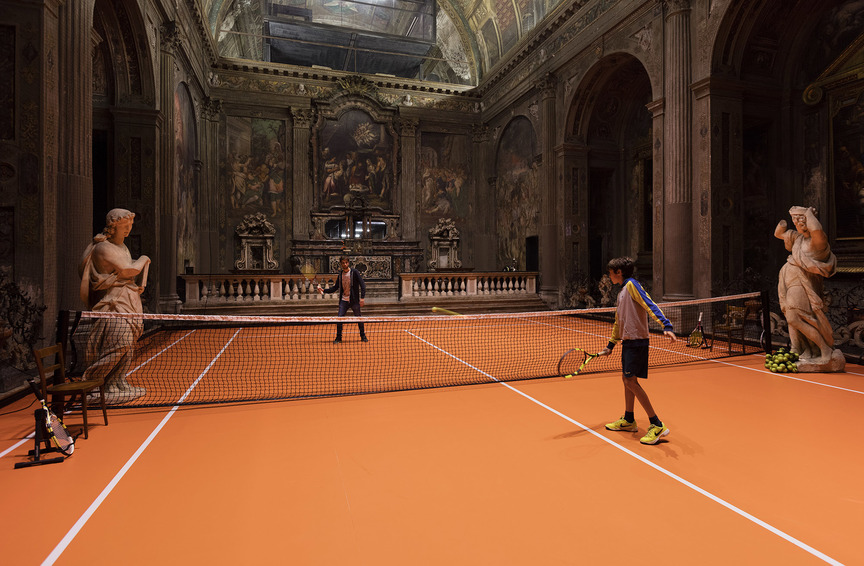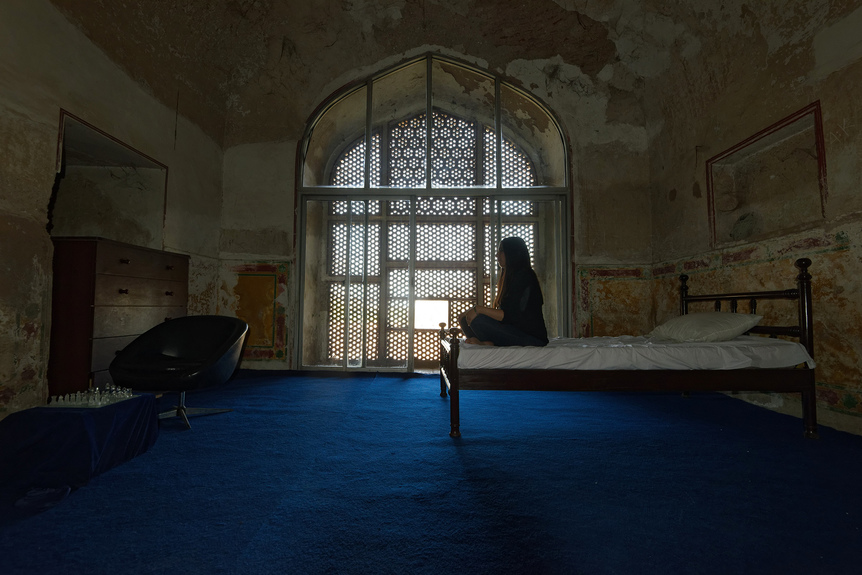
R
E
V N
E
X
T
Ask Asad Raza how he refers to himself and his reply is markedly opaque: “I’m not really anything, but I do everything, depending on what needs to be done.” Born in 1974 in Buffalo, New York, to Pakistani immigrants, Raza is a graduate of John Hopkins University’s literature department and New York University’s film program. His practice is predicated on the conversations between the “cultivators”—collaborators whom Raza engages for his projects—and the visitors to the architectural environments or mise-en-scènes that he constructs. By provoking “metabolic” and live exchanges between visitors, facilitators, and the spaces that they occupy, Raza seeks to challenge the conventions of how we interact with or define art.
In 2015, Raza constructed an exhibition attached to the bookshop of Frieze London art fair, staging a series of performative interactions inspired by the worship rituals for the Greek god Pan, and the caves in which these actions unfolded. That same year, he opened up his own apartment, inviting collaborators to intervene in the environment and his daily routine. In 2017, he turned a deconsecrated church in Milan into a tennis court for the live installation Untitled (Plot for Dialogue) (2017), and brought a series of potted trees along with a taskforce of tree-minders into New York’s Whitney Museum of American Art as part of Root Sequence. Mother Tongue (2017). Most recently, he has been commissioned to create a site-specific installation for the Kaldor Public Art Project’s 50th anniversary, titled Absorption (2019), in Sydney. ArtAsiaPacific sat down with the artist to discuss his treatment of exhibition spaces, the influences behind his live art, and his new work.
Installation view of ASAD RAZA’s Root Sequence. Mother Tongue, 2017, 26 trees, UV lighting, customized scents, carpet, and cabinet with possessions of caretaker, dimensions variable, at the Whitney Biennial, Whitney Museum of American Art, New York, 2017. Courtesy the artist.
Which artists have impacted your practice?
When I was 16, I went to the Albright-Knox Art Gallery in my home town and saw a show there by Jenny Holzer. That her text works could be art had a profound impact on me. Philippe Parreno’s 2014 solo exhibition “Anywhere, Anywhere Out of the World” at the Palais de Tokyo in Paris was a revelation in terms of Parreno’s treatment of space and collaboration with other artists. And then there’s Tino Sehgal. Sehgal’s work has had an effect on me as it has on every other artist in the contemporary art world. It was intriguing to me how there is very little information about what is going on in his work at his exhibitions. There is no brochure, wall text, or anything.
You worked with Sehgal for several years as a producer. How did this come about?
I met him through a mutual friend in 2007, and he asked if I could help produce his work. The first major project I worked on with him was This Progress (2006), which involves a series of guides asking visitors about their conception of progress, shown at his 2010 show at the Solomon R. Guggenheim Museum in New York. I continued working with him until 2015.
When did you start making projects under your own name?
I was invited to make something for Frieze London in 2015. I created a cave-like space that you entered through a book store. There, performers told personal stories interspersed with myths. The emphasis was on the visceral quality of the encounter, free of any intellectual rationale, contrasting the bookstore. From there, I got more invitations to do stuff under my own aegis. I had done other things in experimental performance spaces in New York, but 2015 was when I started to think about how to treat the exhibition space on my own.
In 2015, you made Home Show in your New York apartment. What was the conceptual premise behind this work?
I invited 20 or so artists—including Tino Sehgal, Adrian Villar Rojas and Carsten Holler—all of whom I knew well, to intrude into my life and personal space. Sehgal had me ask visitors an unexpected question; Rojas created a sculpture in my freezer, made of fruit and even a lobster; and Holler produced what he called a dream-inducing toothpaste. I didn’t want the exhibition to be what I call a cemetery of objects, so I didn’t clear out the premise, I wanted it to be a lived-in, social environment. I made a rule that I would not announce it on social media, or any website, and I didn’t do any mass emails about it either. I only communicated with people one on one. I would send a short message to someone I thought might be interested in seeing the show, and from this interest grew. It was open for five weeks, and for the first few days, one or two people came to see the show. Toward the end, 20 people were coming each day. It was very exhilarating and exhausting.
Your projects are often concerned with the interactions between people and the space of your work. Why?
I am interested in how people occupy or inhabit space—“inhabit” being a good word for how people experience my work. Museums sometimes make visitors feel like they don’t belong. I’m interested in breaking that down and creating spaces that are both public and intimate at the same time. I like to create autonomous zones where you have a different kind of experience, and where you are not being told what to do.
Untitled (Plot for Dialogue) (2017) is another one of your works that was shown outside of an institutional white-cube environment. What was this work about?
Untitled (Plot for Dialogue) was set in the deconsecrated Renaissance church, San Paolo Converso, in Milan. I wanted to create a space for an encounter but I figured the experience should be meditative because it is a church. I’m fascinated with tennis and the exchanges that take place in the meditative, warm-up period. So I built a clay court in this church, beneath frescos and sculptures that were created in 1564, the year Michelangelo died, and invited young tennis players to play tennis with the visitors. After the game, visitors could sip jasmine tea at the deconsecrated altar and exchange stories.
In 2018, you made The Bedroom—your first work in Pakistan—for the inaugural Lahore Biennale. What is the concept behind this work?
The biennale gave me an amazing space in the 400-year-old royal quarters of the Mughal Summer Palace in the Lahore Fort. There, as part of The Bedroom, visitors met a teenager who sang and played chess with them, which I imagined were the activities that would have happened in the royal chambers. Walking around the largely untouched, old city, you feel that there were and are a great amount of exchanges happening between people. I wanted to recreate this energy in the palace. My parents met in Lahore at medical school, and I found it very touching to be in the city. Though I have been to Lahore many times before, creating a work there was an incredible experience.
What can we expect to encounter with your new commission, Absorption?
For Sydney, there are three main groups of local protagonists whom I want to bring into the project—scientists and researchers who are working on ecological issues, local artists, and the group I call the “cultivators” who don’t come from a specific background. There will be collaborations between these groups and the visitors, mixing organic and inorganic materials. Together, we will create a living process.
How does this work relate to your general practice?
My practice is hard to describe but it involves what I call metabolic, living processes that play out through an exhibition. I’ve been looking at live art modes for a while, and over time I’ve tried to bring more diverse elements into various situations that can be changed and impact other components in the process.
Many contemporary artists are still working in a way where they think of their work as the starring element and the source of meaning in an exhibition, rather than as a component in relation to the situation. For them, it is about erasing the negative space. I’m not interested in that. It’s important for me to orchestrate a conversation with the voices of the place.
Michael Young is a contributing editor of ArtAsiaPacific.
Asad Raza’s Absorption can be experienced from May 3 to 19, 2019, at The Clothing Store, Carriageworks, Sydney.
To read more of ArtAsiaPacific’s articles, visit our Digital Library.



















